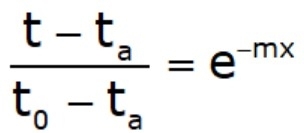Heat Transfer from Extended Surface (Fin):
- A fin is a surface that extends from an object to increase the rate of heat transfer to or from the environment by increase convection.
- Adding a fin to an object increases the surface area and can sometimes be an economical solution to heat transfer problems.
- Finned surfaces are commonly used in practice to enhance heat transfer. In the analysis of the fins, we consider steady operation with no heat generation in the fin.
- We also assume that the convection heat transfer coefficient h to be constant and uniform over the entire surface of the fin.
- The rate of heat transfer from a solid surface to atmosphere is given by Q = hA ∆ T where, h and ∆T are not controllable.
- So, to increase the value of Q surface area should be increased. The extended surface which increases the rate of heat transfer is known as fin.
Generalized Equation for Fin Rectangular fin:
Where Ac and As are cross-sectional and surface area:
And θ(x)=t(x)–ta

Heat balance equation if Ac constant and As ∞ P(x) linear:
- General equation of 2nd order: θ = c1emx + c2e–mx
- Heat dissipation can take place on the basis of three cases.
Case 1: Heat Dissipation from an Infinitely Long Fin (l → ∞):
- In such a case, the temperature at the end of Fin approaches to surrounding fluid temperature ta as shown in figure. The boundary conditions are given below
- At x=0, t=t0 : θ = t0 – ta = θ0
- At x =L→ ∞: t = ta, θ = 0

θ = θ0 e–mx

- Heat transfer by conduction at base:

Case 2: Heat Dissipation from a Fin Insulated at the End Tip:
- Practically, the heat loss from the long and thin film tip is negligible, thus the end of the tip can be, considered as insulated.
- At x=0, t=t0 and θ = t0 – ta = θ0
at



Case 3: Heat Dissipation from a Fin loosing Heat at the End Tip:
- The boundary conditions are given below.
- At x=0, t = t0 and θ = θ0
- At x=l
Qconduction = Qconvection


Fin Efficiency:
Fin efficiency is given by:
- If l → ∞ (infinite length of fin):

- If fin is with insulated tip:

- If finite length of fin:

Note: The following must be noted for a proper fin selection:
- The longer the fin, the larger the heat transfer area and thus the higher the rate of heat transfer from the fin.
- The larger the fin, the bigger the mass, the higher the price, and larger the fluid friction.
- The fin efficiency decreases with increasing fin length because of the decrease in fin temperature with length.
Fin Effectiveness:
- The performance of fins is judged on the basis of the enhancement in heat transfer relative to the no‐fin case, and expressed in terms of the fin effectiveness:

- For a sufficiently long fin of uniform cross‐section Ac, the temperature at the tip of the fin will approach the environment temperature, T∞. By writing energy balance and solving the differential equation, one finds:


where Ac is the cross‐sectional area, x is the distance from the base, and p is perimeter. The effectiveness becomes:
To increase fins effectiveness, one can conclude:
- The thermal conductivity of the fin material must be as high as possible
- The ratio of perimeter to the cross‐sectional area p/Ac should be as high as possible
- The use of fin is most effective in applications that involve low convection heat transfer coefficient, i.e. natural convection.
No comments:
Post a Comment
Knowing brings controversy